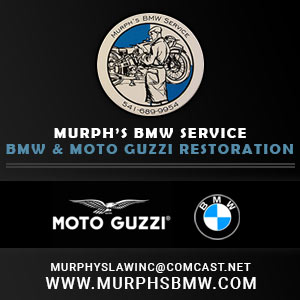Brake Hose Failure - Causes & Cures
Good braking is one of the more mandatory aspects of a "good motorcycle". As dangerous as motorcycle riding is, failure to maintain your braking system in an optimal condition amounts to a gross oversight of the highest order. Yet, you can do all the scheduled BMW maintenance, and still be negligent in your maintenance. That's what this article is about.
Unless you deal mainly with classic motorcycles, you may be totally unaware of the issue. There is a silent, invisible and deadly flaw on most motorcycles over 8 years old. And because the chance of failure increases with AGE, its likelihood is much higher on classic Airheads than it is on younger models.
The culprit is the flexible brake lines found on all motorcycles with disc brakes. These are the black rubber hoses that allow the suspension parts to move, while the master cylinders stay rigidly attached to the frame and handlebars. The problem is found on ALL brands, and ALL models. BMWs simply age more gracefully than other brands, therefore we can expect a higher likelihood of brake hose failure on our Airheads !
Factors Contributing to Failure
• Age is the number one factor
• Amount of flexing the hose endures
• Infrequent brake fluid maintenance
Symptoms
• Difficulty rolling the motorcycle
• Inability to spin the wheel, even when suspended off the ground
• Brake lamp staying ON
• Slowing while "coasting" downhill
• Warped brake rotors
• Rapid friction lining wear
• Difficulty "bleeding" the brakes
• Difficulty refitting the disk into the caliper after wheel removal
Explanation
What's happening is that the flexible brake hoses are made of multiple layers of tubing and reinforcing fibers. The extremely caustic nature of DOT3 and DOT4 brake fluid chemically attacks the inner tubing, causing a physical weakening. DOT4 may become even more caustic over time, meaning bikes brought out of long-term storage may have increased susceptibility. This physical weakening is further enhanced by the bending of the hose itself, meaning that hoses which flex to allow suspension members to move are usually more likely to fail than those that allow infrequent handlebar adjustments.
Detection
If you are experiencing any of the symptoms listed above then obviously you are a prime candidate, and immediate hose inspection is required. When the suspect hose is removed and cleaned, low pressure (1 psi) air should be able to freely travel in both directions. Failed hoses can be anywhere from 20% up to 100% blocked.
However, there are other signs of the long, slow degradation which can be apparent well before complete blockage occurs. It's not just the inner lining that fails on these type hoses. Simply due to repeated use, the reinforcing fibers also loose their strength. Wrap your hand around each flexible hose and then apply the brake HARD. If you feel the hose expanding, then that is most definitely a sign of lost braking efficiency as well as a probable sign of eminent failure.
To the engineer, a brake hose that expands under pressure is a sign of lost braking efficiency. Simply put, fluid pressure that should be going to stop the vehicle is being utterly wasted by doing the needless job of expanding the rubber hose. Clearly, the most efficient braking systems are the ones that convert 100% of the fluid pressure created in the master cylinder into stopping power.
Suggested Corrective Action
Therefore the optimal solution is one in which the inner hose resists the ravages of DOT4 brake fluid, AND one which has a reinforcing structure with the ability to withstand immense internal pressures. Enter the "stainless steel" brake hose.
About 30 years ago brake hoses were introduced with a Teflon ("PTFE") inner hose. As is common knowledge, Teflon is resistant to a large number of chemicals, including DOT4 brake fluid. To reinforce this tubing against expansion under high pressures, the PTFE hose was wrapped in a stainless steel braid giving it tremendous physical strength. Within the last 20 years an outer coating of vinyl has been added to protect plastic parts against abrasion from the braided wire. These outer coatings are now available in clear, black, and most recently vivid primary colors to match your decorating tastes.

While the color options might be aesthetically appealing, use of this type hose also makes the older disc brake systems much more efficient. To the rider, it feels as if the braking system power has been magically doubled. Addition of these modern hoses allows full stopping power with the use of only 2 fingers, which is a much safer hand position for general riding. Bottom line: There are multiple benefits to this upgrade.
Sources
Having been around for 30 years there are multiple sources available. You only need to decide what works best for you, your bike, and your budget. Remember that most motorcycle installations (especially those with fairings) will require the optional exterior vinyl coating simply to protect other parts of the motorcycle. If you want the basic "look" of OEM hoses, then order the Black color option.
• For off-the-shelf solutions, the number one suppliers are Spiegler and Galfer.
https://spieglerusa.com/brakes.html
https://galferusa.com/products/lines
• For slightly custom lengths or fittings, try Bob's BMW. They offer stock lengths as well as build hoses to order. https://www.bobsbmw.com/store/products/brake-lines
• For the DIY guy possibly wanting to save a few dollars or do a special job like a sidecar, then you can build your own system from factory made-to-order parts. The knowledge you need is: a) German brake lines use a single thread size, 10mm x 1.00 (1 thread per mm). b) You will not see any 10mm banjo fittings, but 3/8 inch is an equivalent. c) Use the hoses and fittings for AN-2 and AN-3 sizes. Suggested sources are Summit Racing, Fragola Performance Parts, and Race Part Solutions.
http://fragolaperformancesystems.com/our-products/
https://www.racepartsolutions.com/browse?category=59298
https://www.summitracing.com/
[NOTE: You may have an industrial hose maker local to you. They will typically make any hydraulic hose, but due to the extreme liability inherent in vehicle braking systems (and possibly Federal DOT law), they will probably refuse to make your "brake hose". ]
Hope this helps
Owning an old Airhead is easy.
Keeping an old Airhead running great is the true test.

Excellent article! I will do a closer inspection of my brake lines but I can see I might very well need new brake lines.
- 27 Forums
- 1,952 Topics
- 11.1 K Posts
- 23 Online
- 11.9 K Members





